Dolomite: A Mineral and a Rock
"Dolomite" is a word that is used by geologists in two different ways: 1) as the name of the mineral dolomite; and, 2) as the name of a rock known as dolomite, dolostone or dolomite rock.
This page is about dolomite rock. If you are looking for an article about the mineral please go here. |
What is Dolomite?
Dolomite, also known as �dolostone� and �dolomite rock�, is asedimentary rock composed primarily of the mineral dolomite, CaMg(CO2)3. Dolomite is found in sedimentary basins worldwide. It is thought to form by the postdepositional alteration of lime mud andlimestone by magnesium-rich groundwater.
Dolomite and limestone are very similar rocks. They share the same color ranges of white-to-gray and white-to-light brown (although other colors such as red, green and black are possible). They are approximately the same hardness and they are both soluble in dilute hydrochloric acid. They are both crushed and cut for use as construction materials and used for their ability to neutralize acids.
Dolomitization
Dolomite is very common in the rock record but the mineral dolomite is rarely observed forming in sedimentary environments. For this reason it is believed that most dolomites form when lime muds or limestones are modified by postdepositional chemical change.
Dolomite originates in the same sedimentary environments as limestone - warm, shallow, marine environments where calcium carbonate mud accumulates in the form of shell debris, fecal material, coral fragments and carbonate precipitates. Dolomite is thought to form when the calcite (CaCO2) in carbonate mud or limestone is modified by magnesium-rich groundwater. The available magnesium facilitates the conversion of calcite into dolomite(CaMg(CO2)3). This chemical change is known as �dolomitization�. Dolomitization can completely alter a limestone into a dolomite or partially alter the rock to form a "dolomitic limestone".
Identification in the Field and Classroom
Dolomite is slightly harder than limestone. Dolomite has a Mohs hardness of 3.5 to 4 and limestone (composed of the mineral calcite) has a hardness of 3.
Dolomite is slightly less soluble in dilute hydrochloric acid. Calcite will effervesce vigorously in contact with cold, dilute (5%) hydrochloric acid while dolomite produces a very weak effervescence.
These differences are often not significant enough to make a positive identification in the field. Distinguishing the rocks in the field is further complicated by a compositional continuum that ranges from limestone to dolomitic limestone to dolomite. A chemical analysis that determines the relative abundances of calcium and magnesium is needed to accurately name the rocks.
�Dolomite Rock� and �Dolostone�
Some geologists are uncomfortable using the word �dolomite� for both a mineral and a rock of the same composition. They instead prefer using �dolomite rock� or �dolostone� when speaking of the sedimentary rock and �dolomite� when speaking of the mineral. Although these terms simplify communication and improve accuracy many geologists continue to use the word "dolomite" for both the mineral and the rock.
Metamorphism of Dolomite
Dolomite behaves like limestone when it is subjected to heat and pressure. It begins to recrystallize as the temperature rises. As this occurs the size of the dolomite crystals in the rock increases and the rock develops a distinctly crystalline appearance.
If you examine the photo below you will see that the rock is composed of easily recognizable dolomite crystals. The coarse crystalline texture is a sign of recrystallization, most often caused by metamorphism. Dolomite that has been transformed into a metamorphic rock is called "dolomitic marble".
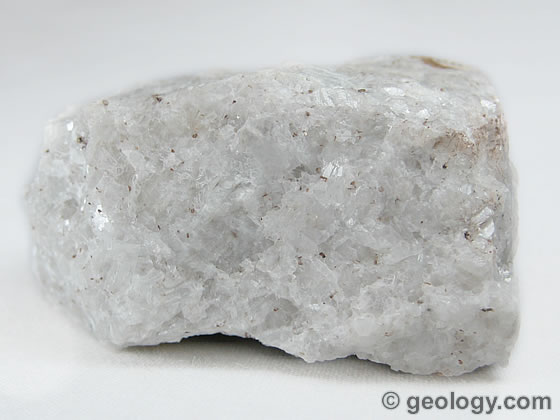
| A specimen of coarsely crystalline dolomitic marble from Thornwood, New York. This specimen is approximately 3 inches (6.7 centimeters) across. |
Uses of Dolomite
Dolomite and limestone are used in similar ways. They are crushed and used as an aggregate in construction projects. They are kiln-fired in the manufacture of cement. They are cut into blocks and slabs for use as a dimension stone. They are calcined to produce lime. In some of these uses, dolomite is preferred. Its greater hardness makes it a superior construction material. Its lower solubility makes it more resistant to the acid content of rain and soil.
The dolomitization process results in a slight volume reduction when limestone is converted into dolomite. This can produce a porosity zone in the strata where dolomitization has occurred. These pore spaces can be traps for subsurface fluids like oil and natural gas. This is why dolomite is often a reservoir rock that is sought in the exploration for oil and natural gas. Dolomite can also serve as a host rock for lead, zinc and copper deposits.
In the chemical industry dolomite is used as a source of magnesia (MgO). The steel industry uses dolomite as a sintering agent in processing iron ore and as a flux in the production of steel. In agriculture dolomite is used as a soil conditioner and as a feed additive for livestock. Dolomite is used in the production of glass and ceramics. Dolomite has been used as a minor source of magnesium but today most magneisum is produced from other sources.
Contributor: Hobart King

|
 |
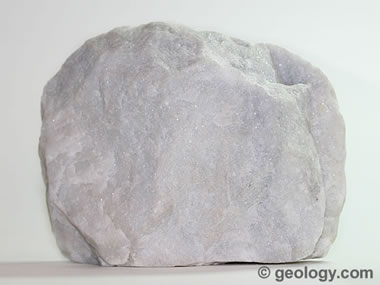
| A specimen of fine-grained dolomite rock from Lee, Massachusetts. It is about four inches (ten centimeters) across. |
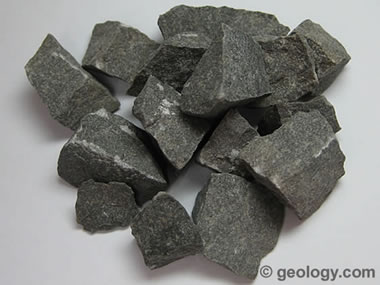
| Dolomite aggregate, used for asphalt paving from Penfield, New York. These specimens are approximately 1/2 inch to 1 inch (1.3 centimeters to 2.5 centimeters) across. |
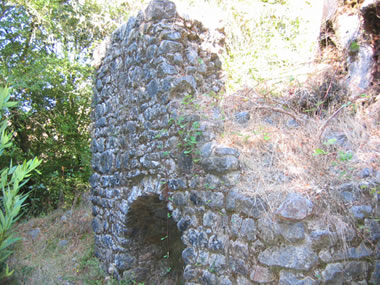
| Dolomite and limestone have been heated in kilns to produce lime for thousands of years. This stone structure is the Olema Lime Kiln, located in Marin County, California, was built in 1850 for the production of lime. National Park Service photo. |
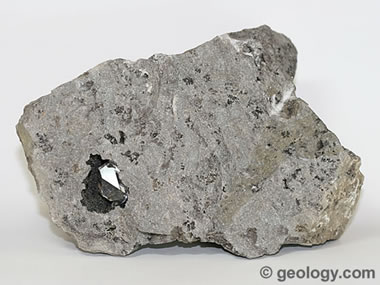
| Photograph of a specimen of the Little Falls Dolostone from Herkimer County, New York. This dolostone is the host rock for the doubly-terminated quartz crystals known as "Herkimer Diamonds". It is vuggy, has a high silica content and is much harder and tougher than the typical domlomite. The Herkimer Diamonds are found in petroleum-lined vugs in the rock unit. Part of a Herkimer Diamond is visible in the large vug on the left side of this specimen. | |